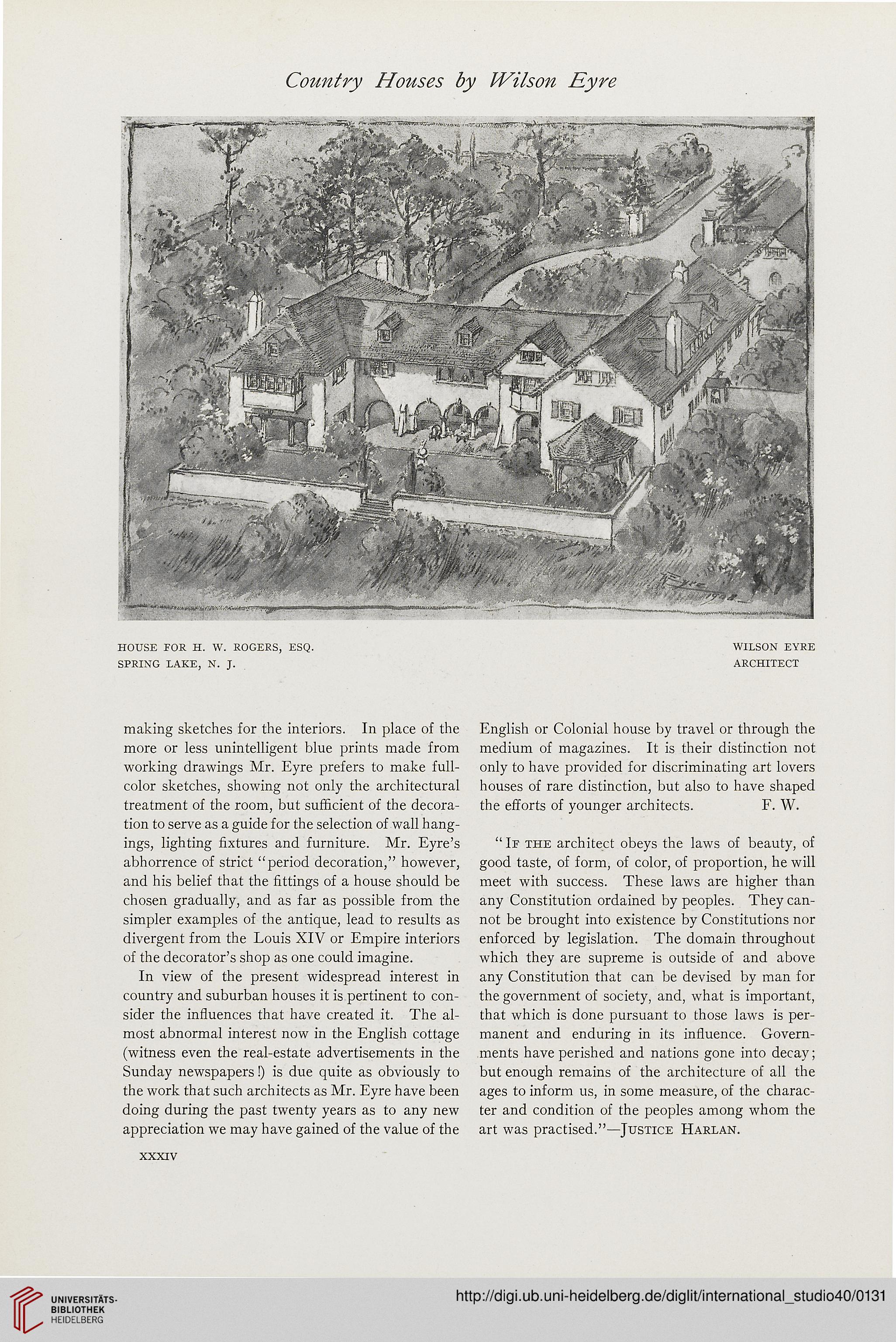Country Houses by Wilson Eyre
making sketches for the interiors. In place of the
more or less unintelligent blue prints made from
working drawings Mr. Eyre prefers to make full-
color sketches, showing not only the architectural
treatment of the room, but sufficient of the decora-
tion to serve as a guide for the selection of wall hang-
ings, lighting fixtures and furniture. Mr. Eyre's
abhorrence of strict "period decoration," however,
and his belief that the fittings of a house should be
chosen gradually, and as far as possible from the
simpler examples of the antique, lead to results as
divergent from the Louis XIV or Empire interiors
of the decorator's shop as one could imagine.
In view of the present widespread interest in
country and suburban houses it is pertinent to con-
sider the influences that have created it. The al-
most abnormal interest now in the English cottage
(witness even the real-estate advertisements in the
Sunday newspapers!) is due quite as obviously to
the work that such architects as Mr. Eyre have been
doing during the past twenty years as to any new
appreciation we may have gained of the value of the
English or Colonial house by travel or through the
medium of magazines. It is their distinction not
only to have provided for discriminating art lovers
houses of rare distinction, but also to have shaped
the efforts of younger architects. F. W.
"If the architect obeys the laws of beauty, of
good taste, of form, of color, of proportion, he will
meet with success. These laws are higher than
any Constitution ordained by peoples. They can-
not be brought into existence by Constitutions nor
enforced by legislation. The domain throughout
which they are supreme is outside of and above
any Constitution that can be devised by man for
the government of society, and, what is important,
that which is done pursuant to those laws is per-
manent and enduring in its influence. Govern-
ments have perished and nations gone into decay;
but enough remains of the architecture of all the
ages to inform us, in some measure, of the charac-
ter and condition of the peoples among whom the
art was practised."—Justice Harlan.
xxxiv
making sketches for the interiors. In place of the
more or less unintelligent blue prints made from
working drawings Mr. Eyre prefers to make full-
color sketches, showing not only the architectural
treatment of the room, but sufficient of the decora-
tion to serve as a guide for the selection of wall hang-
ings, lighting fixtures and furniture. Mr. Eyre's
abhorrence of strict "period decoration," however,
and his belief that the fittings of a house should be
chosen gradually, and as far as possible from the
simpler examples of the antique, lead to results as
divergent from the Louis XIV or Empire interiors
of the decorator's shop as one could imagine.
In view of the present widespread interest in
country and suburban houses it is pertinent to con-
sider the influences that have created it. The al-
most abnormal interest now in the English cottage
(witness even the real-estate advertisements in the
Sunday newspapers!) is due quite as obviously to
the work that such architects as Mr. Eyre have been
doing during the past twenty years as to any new
appreciation we may have gained of the value of the
English or Colonial house by travel or through the
medium of magazines. It is their distinction not
only to have provided for discriminating art lovers
houses of rare distinction, but also to have shaped
the efforts of younger architects. F. W.
"If the architect obeys the laws of beauty, of
good taste, of form, of color, of proportion, he will
meet with success. These laws are higher than
any Constitution ordained by peoples. They can-
not be brought into existence by Constitutions nor
enforced by legislation. The domain throughout
which they are supreme is outside of and above
any Constitution that can be devised by man for
the government of society, and, what is important,
that which is done pursuant to those laws is per-
manent and enduring in its influence. Govern-
ments have perished and nations gone into decay;
but enough remains of the architecture of all the
ages to inform us, in some measure, of the charac-
ter and condition of the peoples among whom the
art was practised."—Justice Harlan.
xxxiv




